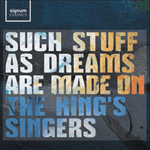
Welcome to Hyperion Records, a British classical label devoted to presenting high-quality recordings of music of all styles and from all periods from the twelfth century to the twenty-first.
Hyperion offers both CDs, and downloads in a number of formats. The site is also available in several languages.
Please use the dropdown buttons to set your preferred options, or use the checkbox to accept the defaults.

| The King's Singers» More |
from notes by Collegium Records © 2002
 Such stuff as dreams are made on Such stuff as dreams are made on“This album is an exploration of European choral music from the early 20th century (and a bit either side), much of it shaped and scarred by the spectre of conflicts that dominated the continent in that period. For us, it has been a chance to deve ...» More |

